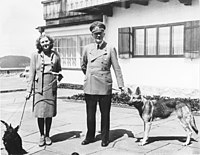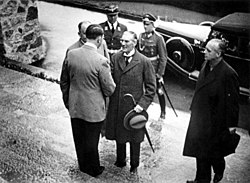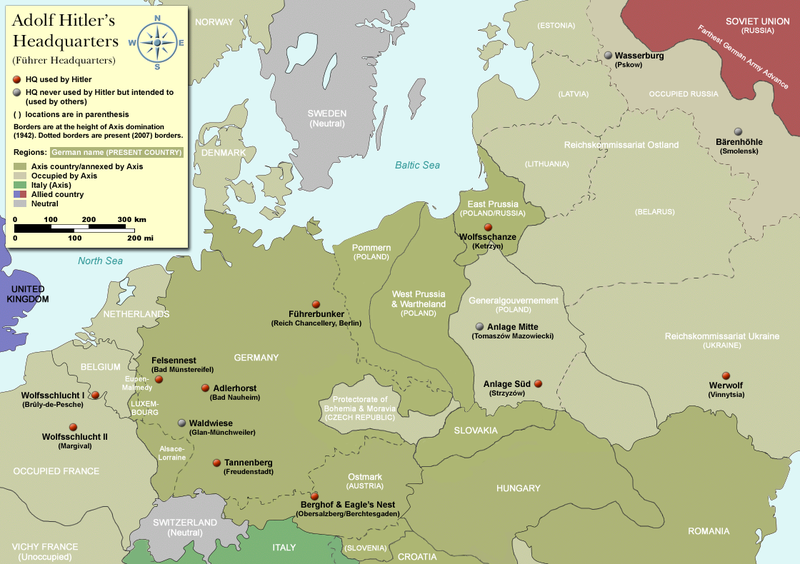Berghof (residence)

Multi tool use
| The Berghof | |
|---|---|
Berghof | |
 "The Berghof" on the Obersalzberg, the house of Adolf Hitler. In the foreground, the main entrance. | |
 Location within Germany | |
| Former names | Haus Wachenfeld |
| General information | |
| Status | Demolished |
| Type | Chalet |
| Location | Obersalzberg |
| Town or city | Berchtesgaden |
| Country | Germany |
| Coordinates | 47°38′01″N 13°02′31″E / 47.63361°N 13.04194°E / 47.63361; 13.04194Coordinates: 47°38′01″N 13°02′31″E / 47.63361°N 13.04194°E / 47.63361; 13.04194 |
| Elevation | 921 m (3,022 ft) |
| Construction started | 1916 |
| Renovated | 1935–1936 |
| Demolished | April 25, 1945 |
| Owner | Adolf Hitler |
| Design and construction | |
| Architecture firm | Hochtief AG |
The Berghof was Adolf Hitler's home in the Obersalzberg of the Bavarian Alps near Berchtesgaden, Bavaria, Germany. Other than the Wolfsschanze ("Wolf's Lair"), his headquarters in East Prussia for the invasion of the Soviet Union, Hitler spent more time at the Berghof than anywhere else during World War II. It was also one of the most widely known of his headquarters,[1] which were located throughout Europe.
Rebuilt, much expanded and renamed in 1935, the Berghof was Hitler's vacation residence for ten years. In late April 1945 the house was damaged by British aerial bombs, set on fire by retreating SS troops in early May, and looted after Allied troops reached the area. The Bavarian government demolished the burnt shell in 1952.
Contents
1 History
1.1 Guests
1.2 British assassination plan
2 Post-war ruins
3 Location of the Berghof and Adolf Hitler's other headquarters
4 See also
5 References
5.1 Notes
5.2 Bibliography
6 External links
History
The Berghof began as a much smaller chalet called Haus Wachenfeld, a holiday home built in 1916 (or 1917) by Kommerzienrat Otto Winter, a businessman from Buxtehude. This was located near the Platterhof, the former Pension Moritz where Hitler had stayed in 1922–23. By 1926, the family running the Pension had left and Hitler did not like the new owner. He moved first to the Marineheim and then to a hotel in Berchtesgaden, the Deutsches Haus, where he dictated the second volume of Mein Kampf in the summer of 1926. Hitler met his girlfriend at that time, Maria Reiter, who worked in a shop on the ground floor of the hotel, during another visit in autumn 1926. In 1928, Winter's widow rented Haus Wachenfeld to Hitler and his half-sister Angela came to live there as housekeeper, although she left soon after her daughter Geli's 1931 death in Hitler's Munich apartment.[2]
By 1933 Hitler had purchased Haus Wachenfeld with funds he received from the sale of his political manifesto Mein Kampf. The small chalet-style building was refurbished and much expanded during 1935–36 by architect Alois Degano when it was renamed The Berghof (Mountain Court in English).[3]
A large terrace was built and featured big, colourful, resort-style canvas umbrellas. The entrance hall "was filled with a curious display of cactus plants in majolica pots." A dining room was panelled with very costly cembra pine. Hitler's large study had a telephone switchboard room. The library contained books "on history, painting, architecture and music." A great hall was furnished with expensive Teutonic furniture, a large globe and an expansive red marble fireplace mantel. Behind one wall was a projection booth for evening screenings of films (often, Hollywood productions, including Mickey Mouse).[4]
A sprawling picture window could be lowered into the wall to give a sweeping, open air view of the snow-capped mountains in Hitler's native Austria.[3] The house was maintained much like a small resort hotel by several housekeepers, gardeners, cooks and other domestic workers. "This place is mine," Hitler was quoted as saying to a writer for Homes & Gardens magazine in 1938. "I built it with money that I earned."[5][6][7]

The "Great Hall"

Adolf Hitler and Eva Braun with their dogs at the Berghof.
British Homes & Gardens magazine described him as "his own decorator, designer, and furnisher, as well as architect" and the chalet as "bright and airy" with "a light jade green colour scheme"; caged Harz Roller canaries were kept in most of the rooms, which were furnished with antiques, mostly German furniture from the 18th century. Old engravings hung in the guest bedrooms, along with some of Hitler's small water-colour sketches. His personal valet Heinz Linge stated that Hitler and his longtime companion Eva Braun had two bedrooms and two bathrooms with interconnecting doors and Hitler would end most evenings alone with her in his study drinking tea.[8]
Though Hitler did not smoke, smoking was allowed on the terrace. His vegetarian diet was supplied by nearby kitchen gardens and, later, a greenhouse. A large complex of mountain homes for the Nazi leadership with a landing strip and many buildings for their security and support staff were constructed nearby. To acquire the land for these projects, many neighbours were compelled to sell their properties and leave.[9] A Kehlsteinhaus, nicknamed Eagle's Nest by André François-Poncet, a French diplomat, was built in 1937–38 (with remarkably lavish government funds spent as a national gift for his 50th birthday) on the mountaintop above the Berghof, but Hitler rarely went there.

Venus and Amor by Paris Bordone, that adorned the "Great Hall", was ceded after the war to the National Museum in Warsaw.[10]
The area became something of a German tourist attraction during the mid-1930s. [11] Visitors gathered at the end of the driveway or on nearby public paths in the hope of catching a glimpse of Hitler. This led to the introduction of severe restrictions on access to the area and other security measures.[3] A large contingent of the SS Leibstandarte Adolf Hitler were housed in barracks adjacent to the Berghof. Under the command of Obersturmbannführer Bernhard Frank, they patrolled an extensive cordoned security zone that encompassed the nearby homes of the other Nazi leaders. With the outbreak of war extensive anti-aircraft defences were also installed, including smoke generating machines to conceal the Berghof complex from hostile aircraft.
The nearby former hotel "Türken" was turned into quarters to house the Reichssicherheitsdienst (RSD) SS security men who patrolled the grounds of the Berghof.[12] It was later occupied by the Generalmajor of the Police. (The hotel was rebuilt in 1950 and reopened as a hotel before Christmas, the Hotel zum Türken. Visitors can still explore the historic underground hallways and tunnels that had been used by the Nazis.)[13][14][15]
Several Wehrmacht mountain troop units were also housed nearby. Hence, the British never planned a direct attack on the compound.[16]
Guests
Guests at the Berghof included political figures, monarchs, heads of state and diplomats along with painters, singers and musicians. The important visitors personally greeted on the steps of the Berghof by Hitler included David Lloyd George (3 March 1936), the
Aga Khan (20 October 1937), Duke and Duchess of Windsor (22 October 1937),[17]Kurt von Schuschnigg (12 February 1938), Neville Chamberlain (15 September 1938) and Benito Mussolini (19 January 1941). On 11 May 1941 Karlheinz Pintsch visited the Berghof to deliver a letter from Rudolf Hess informing him of his illegal flight to Scotland. At the end of July 1940 Hitler summoned his military chiefs from OKW and OKH to the Berghof for the 'Berghof Conference' at which the 'Russian problem' was studied.

Adolf Hitler greets British Prime Minister Neville Chamberlain on the steps of the Berghof
Hitler's social circle at his Berghof retreat – which his intimates referred to as "on the Berg"[18] – included Eva Braun and her sister Gretl, Herta Schneider and her children, Eva's friend Marion Schönmann, Heinrich Hoffmann and the wives and children of other Nazi leaders and Hitler's staff who would all pose for an annual group photograph on the occasion of Hitler's birthday. The social scene at the Berghof ended on 14 July 1944 when Hitler left for his military headquarters in East Prussia, never to return.[19]
Silent colour films shot by Eva Braun survived the war and showed Hitler and his guests relaxing at the Berghof. In 2006, computer lip reading software identified several parts of their conversations. Among those identified in the films were Albert Speer, Heinrich Himmler, Joseph Goebbels, Joachim von Ribbentrop, Reinhard Heydrich and Karl Wolff.[20]
Two guests planned to use a visit to the Berghof as an opportunity to assassinate Hitler. On 11 March 1944, Captain Eberhard von Breitenbuch arrived with a concealed pistol with the intention of shooting Hitler in the head, but guards would not allow him into the same room.[21] On 7 June 1944, Colonel Claus Schenk Graf von Stauffenberg planned to detonate a bomb at a meeting there, but his fellow conspirators would not give him approval to do so because Himmler and Hermann Göring were not also present.
British assassination plan
After rejecting suggestions about derailing Hitler's train to Obersalzberg and using poison in the train's drinking water, the British developed a plan named Operation Foxley in 1944. This one called for a sniper to kill Hitler[22] on his daily 15–20 minute walk from the Berghof residence to the Teehaus on the Mooslahnerkopf Hill which had been revealed by a prisoner of war. The operation would be undertaken by a German-speaking Pole and a British sniper, wearing German uniforms, using a Mauser Karabiner 98K with a Mauser sight, after being parachuted into Austria. (They would be housed and led to the area by an anti-Nazi, identified as "Heidentaler", who lived nearby in Salzburg.)[22] The Foxley plan did not proceed due to a dispute as to whether killing Hitler was a prudent idea and the lack of intelligence about his exact daily routine. By the time the plan might have proceeded,
Hitler had stopped visiting his mountain retreat; he never returned to the compound after 14 July 1944.[23]
Post-war ruins

The remnants of the Berghof in 2009
The Obersalzberg was bombed by hundreds of British RAF Lancaster heavy bombers, including aircraft from No. 617 Squadron RAF (the "Dambusters"), which attacked the Berghof on the 25th of April in 1945, five days before Hitler committed suicide in the Führerbunker on the 30th of April and twelve days before the surrender of Nazi German military forces (to the Western Allied nations) on the 7th of May. At least two bombs successfully struck the Berghof and did considerable damage to the building. On 4 May, four days after Hitler's suicide in Berlin, retreating SS troops set fire to the villa. Only hours later, the U.S. 3rd Infantry Division arrived at Berchtesgaden along with the French 2nd Armoured Division. In his interview with the Library of Congress, Herman Louis Finnell of the 3rd Division, 7th Regiment, Company I, stated that he and his ammo carrier, Pfc. Fungerburg, were the first to enter Berghof, as well as the secret passages below the structure. Finnell stated that the hallway below the structure had rooms on either side filled with destroyed paintings and evening gowns, as well as destroyed medical equipment and a wine cellar.[24][25] The American troops reportedly muddled Berchtesgaden with the Berghof and a French Army captain and his driver were the first Allied military personnel to reach the still-smoldering chalet.[26] A French tank crew soon joined them. Over the next few days, Allied soldiers thoroughly looted and stripped the house. The American 1st Battalion of the 506th Infantry Regiment (led by Company C) arrived four days later, on 8 May. The 3rd Battalion of the 506th came into Berchtesgaden by a different route and sustained casualties in a skirmish with the crews of two German 88mm anti-aircraft/anti-tank guns. One of the most notable artifacts taken by American soldiers was the Columbus Globe for State and Industry Leaders, known more commonly as "Hitler's Globe".
The teahouse on Mooslahnerkopf hill was unscathed in the April 1945 bombing raid but by 1951 the house-sized building had been knocked down by the Bavarian government because of its link with Hitler. For 55 years the more or less recognisable teahouse ruins (along with mostly intact basement rooms below) lay in the woods by the 13th hole of the post-war Gutshof (Manor Farm) golf course. These were taken away altogether during the late summer of 2006.
The Berghof's shell survived until 1952 when the Bavarian government demolished it with explosives on 30 April. The Berghof, the houses of Göring and Bormann, the SS barracks, the Kampfhäusl and the teahouse were all destroyed. This had been part of an agreement under which the Americans handed the area back to the Bavarian authorities. There was fear that the ruins would become a neo-Nazi shrine and tourist attraction.[27]
In total, over 50 Obersalzberg Nazi buildings were destroyed. The Platterhof which had been a nearby hostel for visitors to the area was turned into the General Walker Hotel for US troops after the war. It was demolished in 2001.[28]
Location of the Berghof and Adolf Hitler's other headquarters
The Berghof was one of ten headquarters used by Hitler during the war. A further four locations were intended for his use but were never visited by him.

Map showing the location of the Berghof, along with Führer Headquarters throughout Europe.
See also
- Kehlsteinhaus
- Führer Headquarters
- Traudl Junge
Man Hunt, a Fritz Lang film set in 1939 about a hunter aiming at Hitler, based on the novel Rogue Male
- Nazi architecture
Operation Foxley, a British SOE plan to assassinate Hitler in 1944
References
Notes
^ Eberle, Henrik and Uhl, Matthias, The Unknown Hitler, Chapter 11, p. 200
^ Kershaw, Ian (2000). Hitler, 1889–1936, Hubris. Norton. pp. 282–284, 686. ISBN 0-393-32035-9..mw-parser-output cite.citation{font-style:inherit}.mw-parser-output .citation q{quotes:"""""""'""'"}.mw-parser-output .citation .cs1-lock-free a{background:url("//upload.wikimedia.org/wikipedia/commons/thumb/6/65/Lock-green.svg/9px-Lock-green.svg.png")no-repeat;background-position:right .1em center}.mw-parser-output .citation .cs1-lock-limited a,.mw-parser-output .citation .cs1-lock-registration a{background:url("//upload.wikimedia.org/wikipedia/commons/thumb/d/d6/Lock-gray-alt-2.svg/9px-Lock-gray-alt-2.svg.png")no-repeat;background-position:right .1em center}.mw-parser-output .citation .cs1-lock-subscription a{background:url("//upload.wikimedia.org/wikipedia/commons/thumb/a/aa/Lock-red-alt-2.svg/9px-Lock-red-alt-2.svg.png")no-repeat;background-position:right .1em center}.mw-parser-output .cs1-subscription,.mw-parser-output .cs1-registration{color:#555}.mw-parser-output .cs1-subscription span,.mw-parser-output .cs1-registration span{border-bottom:1px dotted;cursor:help}.mw-parser-output .cs1-ws-icon a{background:url("//upload.wikimedia.org/wikipedia/commons/thumb/4/4c/Wikisource-logo.svg/12px-Wikisource-logo.svg.png")no-repeat;background-position:right .1em center}.mw-parser-output code.cs1-code{color:inherit;background:inherit;border:inherit;padding:inherit}.mw-parser-output .cs1-hidden-error{display:none;font-size:100%}.mw-parser-output .cs1-visible-error{font-size:100%}.mw-parser-output .cs1-maint{display:none;color:#33aa33;margin-left:0.3em}.mw-parser-output .cs1-subscription,.mw-parser-output .cs1-registration,.mw-parser-output .cs1-format{font-size:95%}.mw-parser-output .cs1-kern-left,.mw-parser-output .cs1-kern-wl-left{padding-left:0.2em}.mw-parser-output .cs1-kern-right,.mw-parser-output .cs1-kern-wl-right{padding-right:0.2em}
^ abc Ryback, Timothy W. "The Hitler Shrine".
^ https://books.google.ca/books?id=hD7KBQAAQBAJ&pg=PA122&lpg=PA122&dq=Hitler+Berghof+cinema+hollywood+movies&source=bl&ots=U1u4tDLsr4&sig=OfnG0c7x1masuN4qAzy9XqVX6EY&hl=en&sa=X&ved=0ahUKEwiAjrustcjVAhXm5YMKHVPiCskQ6AEISjAF#v=onepage&q=Hitler%20Berghof%20cinema%20hollywood%20movies&f=false, p=122
^ Phayre, Ignatius (November 1938). "Hitler's Mountain Home". Homes & Gardens. Retrieved 19 February 2016.Most of these descriptions come from this 1938 magazine article which was very likely written under a pseudonym by political writer William George Fitzgerald in a tone which has been described as "breathless... Hello!-style." The photographs had all been taken by Heinrich Hoffmann (many of them years earlier) and given to the magazine as publicity handouts. The article happened to surface in 2003 after decades of obscurity, see the Guardian reference below.
^ Waldman, Simon, The Guardian, At home with the Führer, 3 November 2003, retrieved 12 December 2007
^ Speer, Albert (1995). Inside the Third Reich. London: Weidenfeld & Nicolson. pp. 84–85, 134–137. ISBN 9781842127353.
^ Linge, Heinz; Moorhouse, Roger (16 July 2009). With Hitler to the End: The Memoir of Hitler's Valet. Skyhorse Publishing. ISBN 978-1848325449.
^ Connolly. Kate, The Daily Telegraph, Hitler's eyrie becomes a playground for the rich, 2 February 2005, retrieved 18 December 2007
^ Lorentz, Stanisław (1984). Muzeum Narodowe w Warszawie: malarstwo [The National Museum in Warsaw: Painting] (in Polish). Arkady. p. 28. ISBN 978-8321332017.
^ "Hitler's Berghof". thirdreichruins.com.
^ Hoffmann, Peter. (2000). Hitler's Personal Security: Protecting the Führer 1921–1945, Da Capo Press, pp. 181–186.
ISBN 978-0306809477
^ "Visit Hotel Zum Turken WWII Bunkers on your trip to Berchtesgaden". www.inspirock.com.
^ Wilson, James (13 January 2014). "Hitler's Alpine Headquarters". Pen and Sword – via Google Books.
^ Bunkersite.com. "Hotel zum Türken, Obersalzberg - Bunkersite.com". bunkersite.com.
^ Felton, Mark (4 August 2014). "Guarding Hitler: The Secret World of the Fuhrer". Pen and Sword – via Google Books.
^ "When the Duke of Windsor met Hitler". 10 March 2016 – via www.bbc.com.
^ Sereny, Gitta. Albert Speer: His Battle With Truth New York, Knopf (1995). p.111.
ISBN 978-0394529158
^ Kershaw, Ian (2000). Hitler 1936–1945: Nemesis. Penguin Press. ISBN 978-0393049947.
^ Midgley, Neil (22 November 2006). "New technology catches Hitler off guard". The Daily Telegraph. Retrieved 19 February 2016.
^ Stein, Marcel (1 February 2007). "Field Marshal Von Manstein: The Janushead – A Portrait". Helion & Company Limited – via Google Books.
^ ab Russell, Shahan (6 January 2016). "Britain's Plan to Kill Hitler By Having a Sniper Shoot Him During His Daily Walk To The Tea House".
^ Felton, Mark (4 August 2014). "Guarding Hitler: The Secret World of the Fuhrer". Pen and Sword – via Google Books.
^ "Veterans History Project: Interview with Herman Finnell". Library of Congress. 26 October 2011.
^ WTVC NewsChannel 9 (5 June 2014). "The Price of Freedom: World War II Veteran Herman Finnell" – via YouTube.
^ Notin, Jean-Christophe (2 May 2005). "Victoire à Berchtesgaden" [Victory in Berchtesgaden]. L'Express (in French).
^ "Dokumentation Obersalzberg: Obersalzberg between 1945 and today". Institute of Contemporary History. Retrieved 19 February 2016.
^ Philpott, Colin (30 June 2016). "Relics of the Reich: The Buildings The Nazis Left Behind". Pen and Sword – via Google Books.
Bibliography
- GUIDO, Pietro: Hitler's Berghof and the Tea-House – ISEM, Milan, 2° Edition,2013,
ISBN 978-88-87077-07-0
- Eberle, Henrik and Uhl, Matthias, The Unknown Hitler
- Walden, Geoffrey R.: Hitler's Berchtesgaden – A Guide to Third Reich Sites in the Berchtesgaden and Obersalzberg Area, Fonthill Media (2014),
ISBN 978-1-78155-226-1
- Wilson, James: Hitler's Alpine Retreat, Pen & Sword Military, Barnsley, S. Yorkshire, England. (2005) 271 photos of the Obersalzberg complex and biographies of leading Nazi figures.
ISBN 1-84415-263-4
External links
| Wikimedia Commons has media related to Berghof. |
"Dokumentation Obersalzberg" (A permanent exhibition on the history of Obersalzberg and the NS-Dictatorship prepared by the Institute of Contemporary History -IfZ -, Munich and Berlin)- Adolf Hitler's Home on the Obersalzberg, 1927–1945
Berchtesgaden Intercontinental Hotel (new hotel on Goering's former property)
Don't Mention the War, The Sydney Morning Herald, Gary A Warner, August 18, 2006.- Association Nationale des Anciens Combattantes des la Banque de France – in French
Y8MX2eCJiM,cD4,zXG,4gtd9c BXMyQ,a9,5 u,aKieiRC4wsryr2miK4sDZNi3FCDnkoVcHAQbVjvPrRJm,J,TbyaPNCPUyu4,l5R